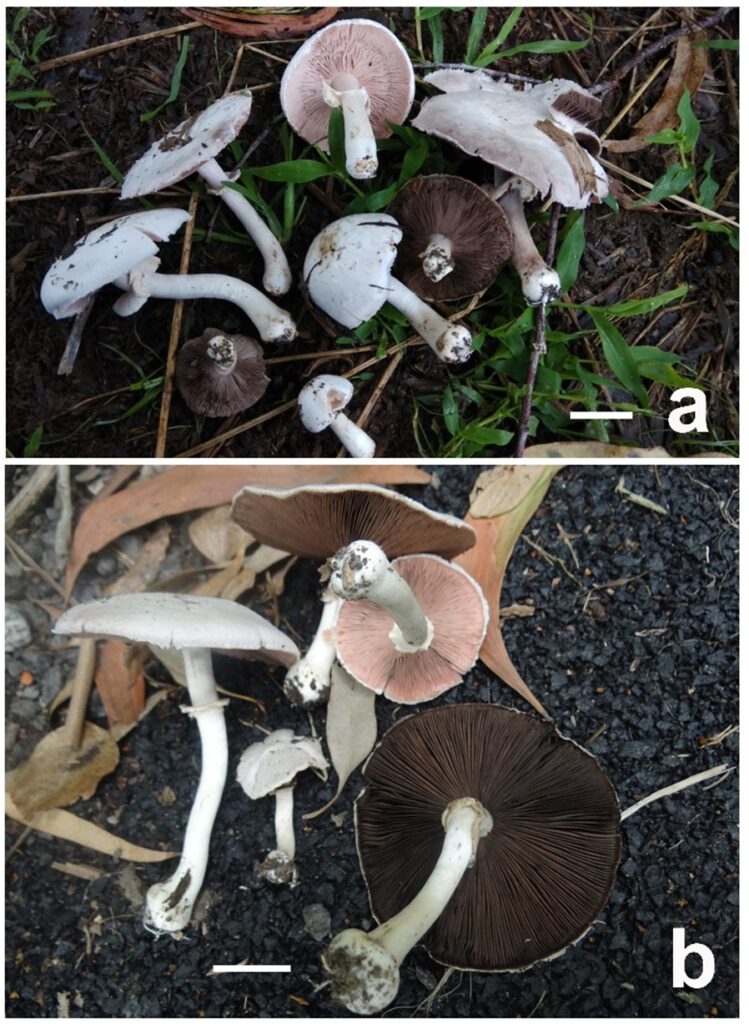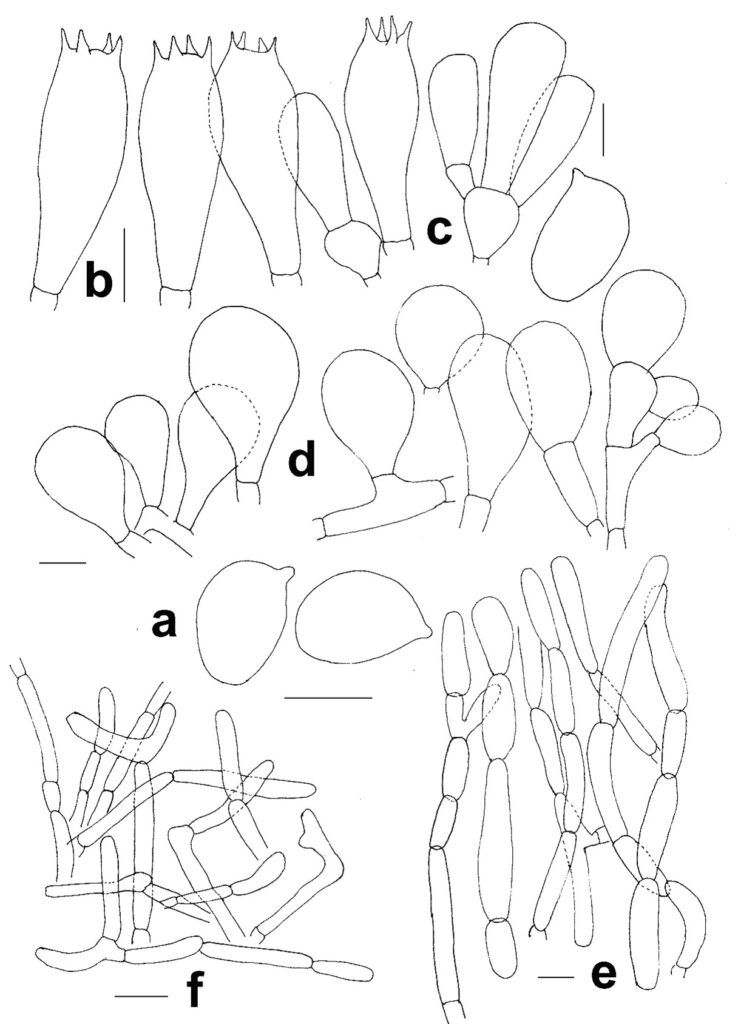Agaricus bambusetorum H. Bashir & Niazi, Scientific Reports 11(12905): 9 (2021)
MycoBank number: MB 828314; Index Fungorum number: IF 828314; Facesoffungi number: FoF 10833;
Description
Pileus 44–95 mm diam., convex when young, becoming broadly convex to applanate with a slight central depression, surface smooth, white (1A1), reddish brown (8D8, 9D-E8) on bruising, margin split radially; context white (1A1), gradually discoloring to light-yellow when cut. Lamellae 5–6 mm broad, free, crowded with up to two series of lamellulae, pinkish to pinkish-brown when young, dark brown (6F6) on maturity, edge entire, concolorous. Stipe 32–96 × 6–12 mm, cylindrical with slightly bulbous base (up to 15 mm), curved at the base, surface smooth, white, immediately turning brown on brushing. Annulus superous, simple, pendant, membranous, thin, smooth in both sides, fragile, white (1A1). Odour pleasant, mushroomy.
Basidiospores (5.9–)7.4–8.5(–8.8) × (3.5–)4.4–5.6(–5.9) μm [Xmr = 6.9–8.3 × 4.5–5.3 μm, Xmm = 7.8 ± 0.9 × 5.0 ± 0.6 μm, Qmr = 1.5–1.6, Qmm = 1.56 ± 0.1, n = 41 spores, s = 3 specimens], ellipsoid, brown to dark brown when viewed with KOH, smooth, with a prominent apiculus measuring 0.8–1.5 µm long. Basidia 15–22 × 5.5–7.5 µm, clavate to broadly clavate, hyaline, 4-spored, sterigmata 1.5–2.5 µm long. Basidioles 12–17 × 4–6 µm, clavate, hyaline, thin-walled. Cheilocystidia 13–37 × 5–17 µm, pyriform to ovoid or broadly clavate, thin-walled, simple septate at the base, basal cells 10–15 × 3.5–5 µm, cylindrical. Pleurocystidia absent. Pileipellis a cutis, composed of hyphae measuring 4.5–7 µm broad, branched, frequently septate, wider at middle, constricted at the septa, elements 5–12 µm broad with round apices. Stipitipellis hyphae 5–8.5 µm broad, cylindrical, parallel, hyaline, smooth, branched, thin-walled. Annulus hyphae 4–7 µm broad, cylindrical, short branched, hyaline, smooth, thin-walled.
Chemistry: KOH reaction positive, pileus surface pastel yellow (1A4) to light yellow (1A5) when fresh, greyish yellow (4C5) on dry specimen; greenish yellow (1A6-7, 1B6-7) on stipe surface; and light yellow (1A5) on lamellae surface. Schäffer’s reaction negative on dry specimen.
Material examined: INDIA, West Bengal, South 24-parganas district, Mathurapur, 22°7’7.24″ N, 88°23’34.43″ E, alt. 8.0 m asl., on leaf litter mixed soil, 04 August 2019, E. Tarafder, CAL 1872; Mathurapur, 22°7’10.25″ N, 88°23’28.78″ E, alt. 10.0 m asl., on leaf litter mixed soil, 07 August 2019, E. Tarafder, CUH AM749; East Midnapur District, Narayangarh, Datan, Jenkapur, 21°53’50.01″ N, 87°22’56.45″ E, alt. 17.0 m asl., on leaf litter mixed soil, 11 August 2019, A. K. Dutta, CUH AM750.
Distribution: The species is reported first time in Pakistan and is currently found in India and reported as a new record.
Sequence data: CAL 1872, ITS: OM278635 (ITS1/ITS4); LSU: ON171824 (LROR/LR3); CUH AM749, ITS: OM278636 (ITS1/ITS4); LSU: ON171824 (LROR/LR3); CUH AM750, ITS: OM278638 (ITS1/ITS4); LSU: OM677380 (LROR/LR3)
Notes: Agaricus bambusetorum was originally described from Pakistan (Bashir et al. 2021) in habitat dominated by bamboo forests. However, in case of the present collection, the specimen was collected growing on leaf litter mixed soil in the roadside vegetation covered by Phoenix dactylifera L. Besides, the cheilocystidia of the present collection shows slightly longer in size compared to the Pakistani collection. In the phylogenetic analyses (Figs. 3–4), three newly generated sequences from the Indian collections clustered together with sequences deposited from Pakistan, suggesting all of them to be the morphotypes of the same taxon.
Among morphologically related taxa: Agaricus biannulatus Mua, L.A. Parra, Cappelli & Callac has a pileus coloured dull to brownish-ochre with ochraceous to brownish-pink scales on its surface, and globose or pyriform to sphaeropedunculate cheilocystidia (Parra et al. 2011). Agaricus hondensis Murrill differs from A. bambusetorum by its larger pileus, phenolic odor, smaller basidiospores (3.4–5.7 × 3.0–3.5 µm), and considerably smaller (10–15 × 10–15 µm), subglobose cheilocystidia (Kerrigan 2016).

Fig. 1. Agaricus bambusetorum (CAL 1872) a Field photographs of the immature stage of the basidiomata showing pileus surface, lamellae colouration, and annulus features. b Mature basidiomata showing lamellae colouration and annulus features. Scale bars: a-b = 20 mm.

Fig. 2. Agaricus bambusetorum a Basidiospores. b Basidia. c Basidioles. d Cheilocystidia. e Pileipellis hyphae. f Annulus hyphae. Scale bars: a-c = 5 μm, d = 10 μm, e = 5 µm, f =15 µm
